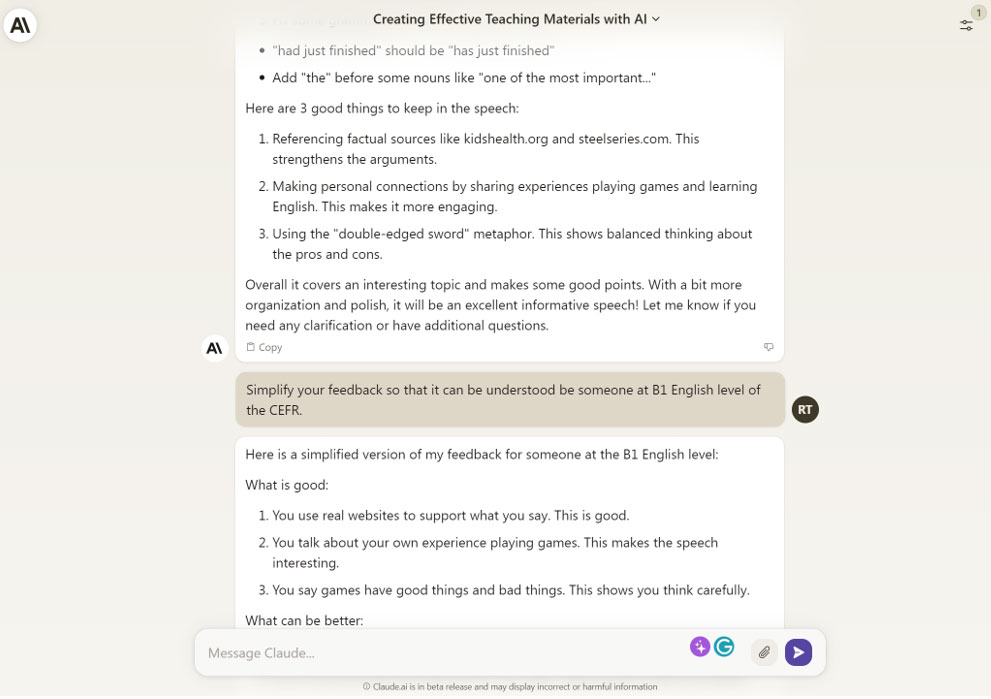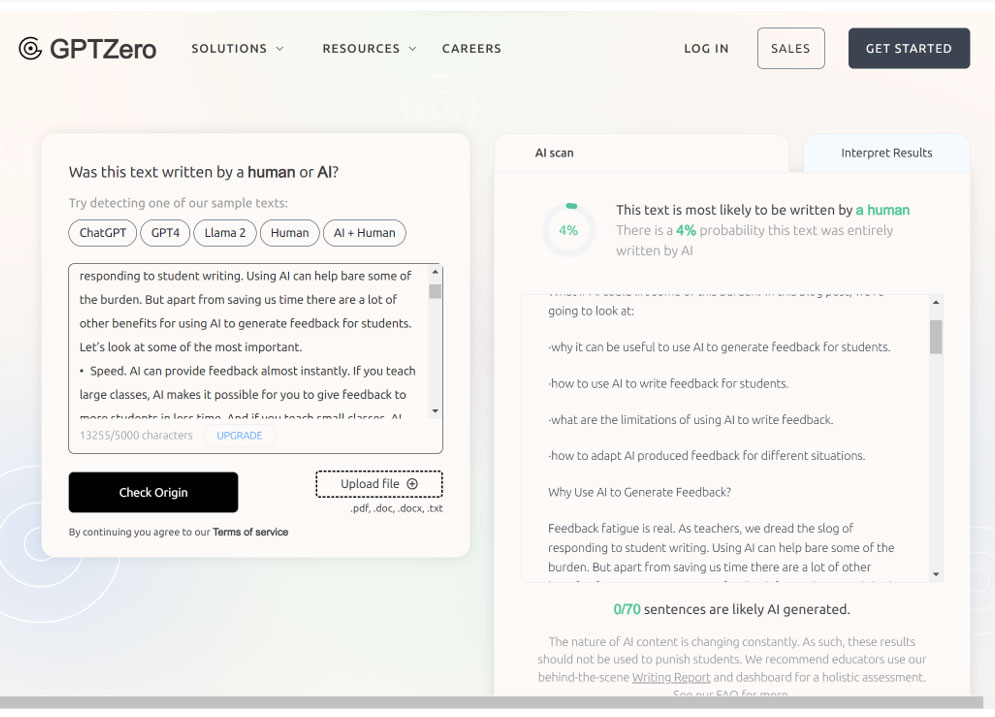2nd February 2024
In 2022, Education Week published an article about how teachers spend their time. They listed over a dozen activities done by teachers on a weekly basis. The number one most time-consuming task? Giving students written feedback. What’s more, the authors noted how teachers spend their time fuels the ever-falling job satisfaction in the profession. Teaching has changed a lot over the past few decades, and while we can’t do much to alter salaries or the decrease in prestige, we might be able to lift some of the feedback burden. In this blog post, we’re going to look at:
- how to use AI to generate feedback for students.
- some of the benefits of integrating AI in the feedback process.
- Are (understanding?) the limitations of using AI to give feedback.
- how to adapt AI produced feedback for different situations.
Why Use AI to Generate Feedback?
Feedback fatigue is real. As teachers, we dread the slog of responding to student writing. Using AI can help bear some of the burden. But apart from saving us time there are a lot of other benefits for using AI to generate feedback for students. Let’s look at some of the most important.
- Speed. AI can provide feedback almost instantly. If you teach large classes, AI makes it possible for you to give feedback to more students in less time. And if you teach small classes, AI can allow you to give your learners feedback more often.
- Quality. Text-to-text AI can generate top-notch feedback that is detailed and specific. It can identify issues in many areas including grammar, lexis, structure, logical flow, and even style or tone.
- Accessibility: Generative AI can provide instant feedback to students. Students can receive feedback on their writing in real-time. Real-time feedback helps students quickly identify and correct errors. Learners can improve their writing skills, without you needing to read their work.
- Objectivity: AI isn’t influenced by personal biases or preconceptions. This can help to eliminate subjective evaluations and ensure that feedback is based only on students’ writing. You can be sure that Chat GPT’s negative comments about Johnny’s writing aren’t because you’re annoyed at him for messing around in class today.
- Perspectives: Just as it might be useful for students to get feedback from more than one teacher, AI can give a different perspective on students’ writing. AI might notice errors you overlooked and find positives that you missed.
- General feedback: If you have a set of essays that you’re copying and pasting into an AI text-generator, you can also ask for general feedback on your class’s strengths and weaknesses. AI can suggest what to focus on in future classes based on these essays.
What Makes Feedback Useful for Students?
Before we dive into the details of using AI to generate feedback, let’s take a moment to look at what makes feedback useful for students. Afterall, there’s no point in getting AI to write feedback for your class if they’re not going to read it. For feedback to be effective, it needs to be:
- Fast. Students need to get feedback as quickly as possible after writing something. The longer the students wait, the more likely it is that they’ll forget what they were writing about in the first place.
- Timely. Feedback is best given when it will be most useful. Feedback on a draft of an essay is much more useful than feedback on the finished product. Feedback on a draft can be used to improve the draft. It’s much harder to use feedback on a completed essay.
- Motivating. We’re more likely to read feedback or accept suggestions when we want or need help. Students are more likely to read and use feedback on a draft of something that they are going to be assessed on compared with something that they’re not. The higher stakes the assignment, the more motivated students will be to read and act on your suggestions.
- Balanced. Effective feedback should include both positive and negative comments. Positive feedback helps students see what they should keep doing and encourages them. Constructive feedback helps students pinpoint what to change. Too much constructive feedback might make students think, “I’m not good at this” and give up. Too much positive feedback and students will not know where to improve.
- Student-directed. Students are more likely to read and act on suggestions if they asked for them. Thinking about which aspects of their writing they want help with will encourage students to think critically about their own writing. Your comments shouldn’t be limited to these areas, but they’re great to include.
- Followed up on. Follow up shows that you value feedback and how students used it. You could ask students to write at the top of the final essay how they used feedback on the draft to improve the final version. (Learners could even be given a mark for this.) You could also ask students to look at and summarize feedback on their previous essay before starting a new one. This encourages students to carry learning forward.
Now that’s out of the way, let’s look at how to use AI to generate feedback for students.
Generating Feedback using AI
For any piece of writing, there are many areas on which you could comment. Whether you focus on grammar errors, ideas or structure will be influenced by a combination of your personal preference, what your students need and what you taught recently. AI doesn’t work like this. AI doesn’t know what your bugbears are, what challenges Johnny usually has, or what you taught last week. That means you need to tell the AI what areas you want it to give feedback on. If you don’t specify something, the AI will probably give feedback on something that you’re not interested in. (This can also be an advantage. We all have our own areas of expertise and blind spots. AI might notice areas for improvement that you’d never thought about before.)
When asking AI to generate feedback, you need to tell the AI:
- the level of your students. The feedback you would give an A2 learner would be very different to the feedback you might give a B2 student.
- the genre of writing. Is it a script for a speech or a personal statement for university? Are we looking at an argumentative essay, or a diary entry for the class teddy bear?
- the writing prompt that the learner is responding to. What question is being answered?
Below is a general prompt to ask for written feedback:
Prompt: Look at the [genre of writing] below. This was written by [a description of your student]. They are answering the question, [question]. Give the student feedback on this so that they can improve their writing. Please include comments on [area of language]. Text: ###
This should generate feedback on areas that you want to give your students feedback on.
Structuring Useful Feedback
Feedback has the potential to inspire students. But it also has the power to demotivate. Overly critical feedback can have the opposite effect from what we intend. It’s important we keep feedback balanced. When you ask AI to generate feedback for students on an essay, suggest how many positive comments you want compared with how many suggestions or corrections. You might write:
Prompt: Look at the [genre of writing] below. This was written by [a description of your student]. They are answering the question, [question]. Write [number] suggestions to improve this as well as [number] things that are good about the text, that the student should keep doing. Text: ###
You might not agree with all the feedback. It’s useful to ask for more information than you plan to send the student. You can then choose the best comments and use these. Using more than one AI platform (for example using both ChatGPT and Claude) can also give you access to a wider range of feedback ideas.
Grading Language
AI tends to write at a high level unless told otherwise. Therefore, it’s useful to instruct the AI to grade the feedback so that it matches the level of your learners. There’s no point in generating feedback for your students if they can’t read it. Use this follow up prompt to ask AI to grade its language:
Prompt: Simplify your feedback so that it can be understood by a student at [level] English level on the CEFR.

Example from Claude
Encouraging students to ask AI for Feedback
In a future blog post, we’ll look at how students can use AI outside of the classroom. But it’s important to note that if students are giving you their essays, you’re feeding these into ChatGPT, then copying and pasting the results, you’re not doing anything that the students couldn’t do by themselves. Why not cut out the middleman and encourage students to use AI to ask for feedback? The danger here is that students will just ask AI to write their essay for them. If that happens, you’d just be getting an AI to give feedback on something another AI wrote. And that would be a complete waste of time.
However, if done correctly, students can get instant feedback, then work on improving their essays before sending these to you. Adding this extra AI-feedback step should save you time. AI can help students fix simpler issues with their writing. It should also empower students to get feedback when they need it most. Using AI to get feedback is also an important skill for students to learn. This is what they’ll need to do to be successful in the future when they’re in the workplace. If your students aren’t going to learn this skill from you, who is going to teach them?
Give your students simple prompts which they can copy and paste into AI to generate feedback on their essays. For example,
Prompt: Please give me five suggestions on how I can improve my writing. Tell me in simple English. Writing: ###
Lower-level students can even ask for this feedback in their first language.
Prompt: Please give me suggestions on how I can improve my writing. Tell me in simple English, then tell me again in [language]. Writing: ###
Checking for AI Plagiarism
While we want students to use AI responsibly to ask for feedback, we don’t want them to use AI too much. One of teachers’ biggest concerns nowadays is, “Was this written by Johnny or by ChatGPT?” There are a few ways to tell if students have copied and pasted their work from a text-to-text AI.
- Plagiarism detection tools. Sites like GPT Zero and The AI Detector can read an essay and guess how much was written by a human, and how much was written by AI. Of course, if AI is able to detect and distinguish between AI and human writing, it will probably be able to convert one into the other. Avoid placing too much faith in these programs and do not use these alone to make important decisions.
- Vocabulary choices. AI-generated texts may contain buzzwords and jargon that are commonly used in academic or business writing. You can also look out for phrases that your students often use in class but are absent from an essay.
- Writing style. Look out for sudden improvements in language complexity beyond the student's usual level. These suggest a section has been lifted from elsewhere.
- Comparison. Compare the essay to the student's previous work. Look for discrepancies in writing quality, vocabulary, and focus. Also look for large differences between drafts of an essay. Significant changes may be a sign of AI intervention.
- Limited understanding. Generative AI models may not fully understand the context of the topic being discussed. This can result in text which does not reference important facts discussed in class or misunderstandings of the assignment requirements.
None of these approaches is foolproof. The best policy is for teachers to educate their students on using AI responsibly (more on this in a future blog) and reward student effort in the writing process rather than the end product.

GPT Zero: apparently my writing passes as human
Limitations of using AI for feedback
Just as we don’t want students using AI to write their essays for them, we also don’t want AI to take over the grading process. There are a few important limitations of using AI to generate feedback that you need to be aware of. These include:
- Privacy. Using AI for feedback involves sharing students' work with external systems. This raises privacy issues. Teachers need to carefully consider data protection and check that they are not breaking any school policies or national laws by doing this.
- Overuse. Reading your students’ work is a great way to learn about what your students already know and what they find challenging. If you only use AI to generate student feedback, you’ll know less about your students. As a result, you’ll be less able to plan lessons that meet your students’ needs.
- Lack of personalization. AI-generated feedback won’t have the personal touch that a teacher can provide. It might not address the specific needs and personalities of individual students. Try rewriting comments from AI to match your students’ personalities and your own voice.
- Lacking context. AI won’t know the broader context of your students' work. It won’t know what was said in class last Tuesday or understand in-jokes and cultural references like a teacher can. This can lead to inaccurate feedback.
- Overemphasis on accuracy. AI text generators tend to focus on grammar and syntax. They might neglect other important parts of writing such as creativity, critical thinking, and developing ideas.
Conclusions
Generative AI has exciting potential for written feedback and assessment in language learning. When used thoughtfully, it can help provide timely, detailed, and personalized feedback at scale. However, teachers need to be mindful of the limitations of using AI for this purpose. AI generated feedback might lack nuance, context, and raise privacy concerns. We all need to be aware of these concerns and develop strategies to mitigate them. Be transparent about your use of AI and ensure that you have consent around data privacy. AI is a powerful feedback tool, but not a replacement for your judgment.
Learn More
If you found this blog post interesting and want to take the next step, then sign up for my online workshop "Using AI for Feedback & Formative Assessment." In this hands-on workshop you'll learn step-by-step how to use AI to provide faster, higher-quality feedback to students. We'll cover prompts for generating feedback on different areas of writing, such as grammar corrections, content suggestions, stylistic improvements, and more. You'll come away with customized prompts tailored to your students, as well as strategies for adapting AI produced feedback. Spots are limited to keep the experience interactive. Reserve your place here.
AI for Language Teaching
Master AI, save time and transform your TESOL teaching with our 30-hour course..



